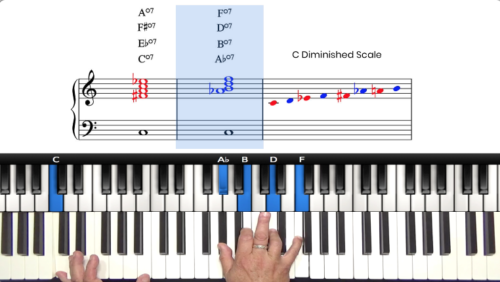Someone To Watch Over Me Tutorial
Welcome to part 2 of this advanced tutorial on “Someone To Watch Over Me”.
The tune follows a standard 32 bar AABA form and there is also a 24 bar introduction which we are going to include in the arrangement.
In part 1 we created an advanced arrangement of the 24 bar introduction and now we will move straight into the head of the tune.
In this lesson we will create some complex voicings and melodic fills, we will introduce a stride left hand style, and finally we will tag the last few bars of the form to create a powerful and dramatic ending.
Slash Notation
All 3 A Sections contain slash notation which can make the form and chord changes intimidating for beginner students.
Slash notation is easy to read and interpret once you understand the basic principles, check out the related lessons below for more information.
Listen To Notable Vocal Versions
If you are not already familiar with the lyrics, then I’d highly recommend that you spend some time to listen to the notable vocal versions.
Learning and memorising the lyrics will helps you with phrasing the melody and also express the meaning of the lyrics musically in your performance.
Practice Tips
-
One of the more challenging aspects of this tune is the descending bassline which is achieved through the slash notation.
-
Slash chords indicate that we are not playing the root of the chord as the lowest note of the voicing.
-
This is typically used to achieve a specific bass note movement.
-
Check out the related lesson above for more information on reading and interpreting slash notation.







Hello Hayden,
I don’t understand something at the 15th minute with the E°7 chord. I don’t see what you are doing with the inversion of the chord, for exemple one of the chord you play it G Db Gb Bb, and so on with the major triads. Do you have a link to a lesson that would help me understand what you are doing with this cool trick?
Thank you very much!
Simon
Hi Simon,
Yes this is a really cool trick and something I must create a lesson on.
It looks complicated, but it’s actually quite simple.
My left hand plays the notes of the diminished chord, in this case Edim7, the notes are E, G, Bb, Db.
My right hand plays a triad build a half step below the chord tones of the diminished chord.
So for the note E in my left hand, my right hand plays an Eb triad, for the note G in my left hand, my right hand plays a Gb triad, for the note Bb in my left hand, the right hand plays an A triad, for the note Db in my left hand, the right hand plays a C triad.
An important point is that each of the right hand triads are in their 2nd inversion.
This pattern can be played up or down the piano, and it can also be used on the related dominant chords. For example, Edim7 is also a rootless C7b9 and so try playing G-7 or G-9 or G-11, and then play exactly what I demonstrate in this lesson, and resolve into some kind of F major. This relationship goes much further too, but try that one to understand how the diminished and dominant function is related.
Practice this slowly, and also notice that the right hand triads are all a minor 3rd apart (C, A, Gb, Eb), in the same way that the notes of the diminished 7th chord are also a minor 3rd apart (E-G-Bb-Db) and in fact if we combine all of these notes, we then have the diminished scale E-Gb-G-A-B-C-Db-Eb
Also all of the notes of triads that I mention (C triad, A triad, Gb triad, Eb triad) are found in the diminished scale E-Gb-G-A-B-C-Db-Eb
Diminished is a fascinating subject, quite tricky to comprehend initially, but this exercise/fill that I am outlining here is a great way to visualise the patterns.
I have added this topic to our upcoming lesson schedule.
Please let me know if I can be of further assistance and have fun playing around with this stuff.
Cheers,
Hayden
Hello Hayden,
Thank you very much for your thorough response, I understand much better now. I am still a bit slow on the right hand but getting better. Also thank you for this great tutorial, I’m learning a lot just working on it and your whole website is a huge source of inspiration.
So thank you for your help! I wish you all my best,
Simon